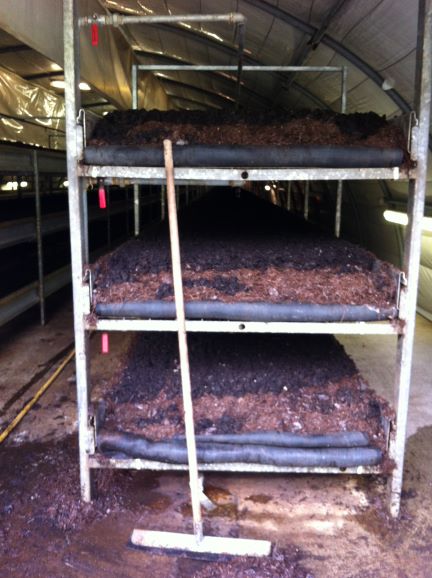Please click here to access the main AHDB website and other sectors.
- Home
- Knowledge library
- Brown Cap Mushroom Virus: Prevent, detect and control
Brown Cap Mushroom Virus: Prevent, detect and control
Read about methods of preventing Brown Cap Mushroom Virus, get tips on how to monitor crops for early signs and see our recommendations for robust disease management.
How to prevent Brown Cap Mushroom Virus
Hygiene is key to preventing infection from viruses. Disinfection alone won’t completely kill mushroom mycelium, as fragments of compost can protect it. So, it’s vital to make sure that equipment, common areas and transport vehicles are thoroughly cleaned of all compost debris, then disinfected and rinsed. This should be carried out after any activity involving compost, such as filling, ruffling and emptying.
You can use high-grade air filtration to reduce contamination from airborne spores or compost fragments.
How to monitor your crops for viral signs
Growers need to watch out for signs of the virus. Train your pickers to spot the symptoms, looking out for off-white, cream or brown-coloured caps, or general poor crop quality. For help detecting the less noticeable off-white discolouration, it’s worth investing in a sensitive colour-measuring device.
As the disease can spread so rapidly, if you suspect a virus, even if symptoms are mild, test a sample straightaway.
Managing the disease
Following strict hygiene rules in all areas where mushrooms and compost are handled is the best disease management strategy. Testing Phase 3 compost regularly for viruses will also help you stay on top of any outbreaks.
Compost facilities
- Tunnels should be steam cooked-out or pasteurised between every batch of Phase 3 compost
- Where possible, fill spawned Phase 2 and empty Phase 3 at different ends of the tunnel and with separate machinery for each activity – the spawning process should be completely isolated
- Remove debris from all surfaces and equipment, including winches and conveyors, before thorough cleaning and rinsing
Growing facilities
- Thoroughly clean and disinfect all equipment and machinery, such as filling heads, conveyors and rufflers
- Wash and disinfect concrete areas and corridors at the end of each day
- Dispose of any waste mushroom material
- Clean and disinfect concrete aprons next to bulk-filling operations and keep them damped down to reduce wind-blown dust
- Carry out filling in isolation (no emptying, picking or cleaning at the same time)
- Close any growing rooms containing mushrooms, while filling
- Clean away debris after rooms are filled and cased, using low-pressure water and a floor scraper
- Anyone involved in filling and casing operations should have no contact with the rest of the farm before starting
- Steam cook-out spent compost and casing at the end of every crop. Do this at a temperature of 65–70˚C for a minimum of eight hours before emptying
- After emptying, clean growing room shelves and netting thoroughly
- Where there have been high levels of Brown Cap Mushroom Disease, lay cleaned nets on growing room shelves and steam the room at 65°C for 2–8 hours
- After emptying spent compost, wash and disinfect growing room floors, shelving and walls, as well as the concrete areas outside
- Maintain growing rooms in good condition – smooth, sealed surfaces and rooms are easier to clean and disinfect
- Remove spent compost, casing soil and mushroom stalks from the site as soon as possible

Debris in a freshly filled growing room which requires thorough post-fill cleaning.
Haulage contractors
Vehicles, trailers, filling heads, hoppers and other equipment that moves between facilities should be cleaned and disinfected (inside and outside) frequently – as a minimum between every location. This is especially important for vehicles that have delivered to farms where a virus has been identified or where there is no steam cook-out in place.
Useful links
Topics:
Sectors:
Tags:

